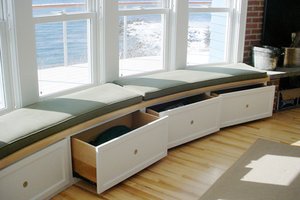| ||||||||||||||||||||||||||||||||||||||||||||||||||||||||||||||||||||||||||||||||||||||||||||||||||||||||||||||||||||||||||||||||
| ||||||||||||||||||||||||||||||||||||||||||||||||||||||||||||||||||||||||||||||||||||||||||||||||||||||||||||||||||||||||||||||||
| ||||||||||||||||||||||||||||||||||||||||||||||||||||||||||||||||||||||||||||||||||||||||||||||||||||||||||||||||||||||||||||||||
| ||||||||||||||||||||||||||||||||||||||||||||||||||||||||||||||||||||||||||||||||||||||||||||||||||||||||||||||||||||||||||||||||
Friday, September 21, 2012
New Mortgage Rates!!
Monday, September 17, 2012
Window Seats
Window Seat Options for Storage Solutions
- Published: October 01, 2010
- By: Jan Soults Walker
- 1Comment
Tagged in:
A window seat can add as much as 13 cubic feet of valuable storage space that doubles as attractive, usable seating for your home.
- Effort: Low 1-2 days
- Investment: Low $600-$800 (kitchen cabinets pl...

If you have an odd-shaped space that would be good for a window seat, have the seat custom made so it'll fit just right. Image: FreeportWoodworking.com
A space-savvy window seat is an attractive, low-cost way to boost your home’s storage potential.
Comfort and storage capacity go hand-in-hand when you add a window seat. The benefits of window seats are many: They de-clutter, provide comfy built-in seating, and add architectural appeal to any room.
Types of window seats
Window seats typically are one of three types. Each type can be made with a storage compartment accessible via drawers, doors, open shelves, or a lift-up seat. An average window seat takes up about 13 cubic feet and provides about that much in storage space.
- Freestanding units are low-cost and portable but aren’t as finished-looking as built-ins. Cost: $200 to $500.
- Custom-crafted window seats give you exactly the look and style you want and can be made to fit into odd-shaped spaces. They are also the priciest option. Cost: $400 to $1,000.
- Modular window seats are built using stock kitchen cabinets from a home improvement center. This is a moderately priced option that the average DIYer can tackle. Select quality construction upper cabinets to achieve the proper height for your window seat base. Add a ¾-inch veneered plywood top, a cushion, and a toe-kick base; paint the unit to complete, if needed. Cost: $600 to $800.
Where to add window seat storage
Position versatile window seats in virtually any room. Some options include:
- For entryway storage, use a window seat to stash boots, shoes, and seasonal or sports gear.
- In playrooms, a kid-friendly seat is perfect for storing toys and games. Use safety hardware that prevents doors or lids from slamming on fingers or trapping kids inside. Outdoor fabrics work best in a kids’ space for stain-resistance and resilience. Also use quality, washable paints or polyurethane finishes over stains.
- In a bathroom, cover window seats with outdoor fabrics and moisture-resistant paint. If possible, install the seat so a heating duct vents through the seat base—towels stored inside will be toasty.
- Niches naturally lend themselves to retrofitting with window seats. Existing niches can be found in a bay window or alcove. Or, your could create a niche by flanking your window using cabinets or bookcases. If you choose to forget the niche, a seat can be successfully positioned on a flat wall.
Window seat installation tips
- Don’t let a floor or wall vent keep you from installing a window seat; simply redirect the vent toward the window seat’s toe-kick, and provide an opening for heated or cooled air to flow into your room.
- Your windows will determine the length of your seat; the height (including the seat cushion) should be 18 to 20 inches, and the depth a comfortable 20 to 24 inches to allow for cushions along the back.
- Building codes require fitting windows near a window seat with tempered glass.
Read more: http://www.houselogic.com/home-advice/home-improvement/window-seat-options-storage-solutions/#ixzz26l7YaSrG
Mortgage Rates!!
Mortgage Rates
|
Updated as of 9/17/2012 10:46:26 AM CST
|
|
Debra Gorman
Phone: (703) 361-9161 Cell Phone: (571) 215-9716 Email: debra.gorman@mortgagefamily. Web Site: http://phhmidatlantic.com |
PHH Home Loans Mortgage Rates. Purchase Price: $425,000, Down Payment: $85,000 (20.00%),
Loan Amount: $340,000 for properties located in State: VA, County: prince william |
Program
|
Loan Amount
|
Monthly Payment
|
Rate
|
APR
|
Points
|
APR Costs
|
Lock
|
$340,000
|
$1,527
|
3.500%
|
0
|
$1,849
|
30 days
| ||
$340,000
|
$2,307
|
2.750%
|
0
|
$1,849
|
30 days
| ||
$340,000
|
$1,411
|
2.875%
|
0
|
$1,849
|
30 days
| ||
$340,000
|
$1,456
|
3.125%
|
0
|
$1,849
|
30 days
| ||
$340,000
|
$1,551
|
3.625%
|
0
|
$1,849
|
30 days
| ||
$344,250
|
$1,498
|
3.250%
|
0
|
$1,849
|
30 days
| ||
$345,950
|
$1,506
|
3.250%
|
0
|
$1,849
|
30 days
| ||
$345,950
|
$1,412
|
2.750%
|
0
|
$1,849
|
30 days
| ||
$340,000
|
$1,623
|
4.000%
|
0
|
$1,849
|
30 days
| ||
$346,939
|
$1,631
|
3.875%
|
0
|
$1,849
|
30 days
| ||
$345,950
|
$1,602
|
3.750%
|
0
|
$1,849
|
30 days
| ||
$340,000
|
$1,648
|
4.125%
|
0
|
$1,849
|
30 days
| ||
See conditions below. APR = Annual Percentage Rate.
| |||||||
* For government programs, actual loan amount is higher due to upfront mortgage insurance added into loan amount. | |||||||
Subscribe to:
Posts (Atom)
